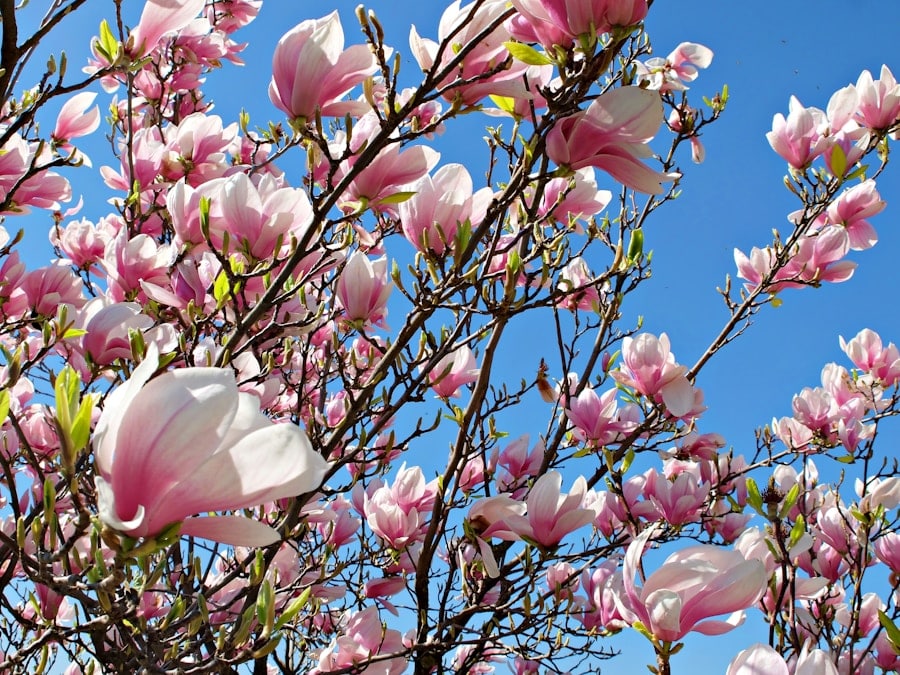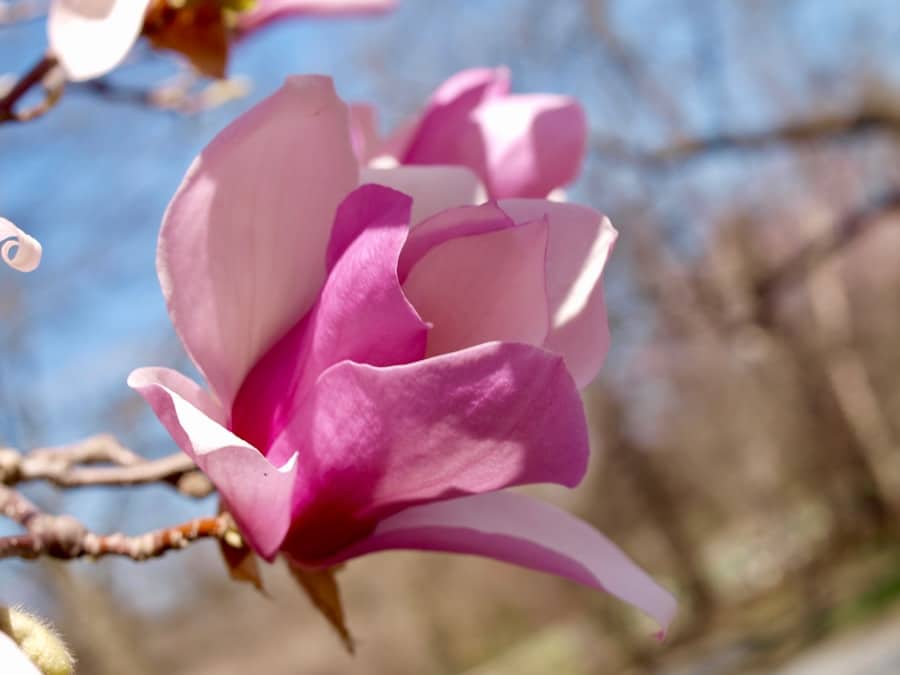The history of the magnolia tree is as rich and layered as its fragrant blooms.
Originating over 20 million years ago, magnolias are among the oldest flowering plants on Earth.
Fossil records indicate that these trees thrived long before bees existed, which is fascinating to me.
Instead of relying on pollinators, magnolias evolved to attract beetles, which played a crucial role in their reproduction. This ancient lineage gives magnolias a unique place in the botanical world, connecting us to a time when the Earth was a very different place. As I delve deeper into the origins of magnolias, I find it intriguing that they are primarily native to Asia and the Americas.
The Southern magnolia, or Magnolia grandiflora, is particularly associated with the southeastern United States, where it has become a symbol of the region’s natural beauty. The tree’s majestic stature and glossy leaves have made it a favorite in gardens and landscapes. Meanwhile, Asian species like the Yulan magnolia (Magnolia denudata) have been cherished in Chinese culture for centuries, often associated with purity and nobility.
This cross-continental appreciation for magnolias speaks volumes about their universal appeal and timeless elegance. Visit Our Site at https://chikusgarden.com/ for more information.
Key Takeaways
- The magnolia tree has a long history dating back to the ancient times, with origins in Asia and the Americas.
- There are over 200 different species of magnolia trees, each with unique characteristics and growing requirements.
- The magnolia tree holds great significance and symbolism in various cultures, representing beauty, perseverance, and dignity.
- Proper care and maintenance, including well-drained soil and regular watering, are essential for growing a healthy magnolia tree.
- The magnificent blooms of the magnolia tree come in various colors and sizes, adding a stunning visual appeal to any landscape.
The Different Varieties and Species of Magnolia Trees
Hybrid Varieties
Some popular hybrid varieties include the Saucer magnolia, which is known for its stunning pink and white flowers that bloom in early spring. I find it particularly delightful to see these blossoms emerge before the leaves, creating a breathtaking spectacle that signals the arrival of warmer weather.
Smaller Varieties
Another fascinating variety is the Star magnolia, known for its star-shaped white flowers that exude a delicate fragrance. This smaller tree is perfect for gardens with limited space, and I appreciate how it can add a touch of elegance without overwhelming the landscape.
Deciduous and Evergreen Species
Additionally, there are deciduous and evergreen species, each offering different aesthetic qualities. The deciduous magnolias shed their leaves in winter, while evergreen varieties like the Southern magnolia maintain their lush foliage year-round. This variety allows me to choose a magnolia that fits my specific gardening needs and aesthetic preferences.
The Significance and Symbolism of the Magnolia Tree

The significance of the magnolia tree extends far beyond its physical beauty; it carries deep cultural meanings and symbolism across various societies. In many cultures, magnolias represent dignity, nobility, and perseverance. I find it particularly poignant that these trees can thrive in diverse environments, symbolizing resilience in the face of adversity.
In the language of flowers, magnolias convey a sense of love for nature and a deep appreciation for life’s fleeting beauty. In addition to their symbolic meanings, magnolias have also played a role in various traditions and rituals. For instance, in some Asian cultures, magnolias are associated with purity and femininity, often used in weddings and other significant life events.
The tree’s ability to bloom beautifully even in challenging conditions serves as a reminder to embrace life’s challenges with grace and strength. This multifaceted symbolism resonates with me, as it encourages reflection on my own experiences and the beauty that can emerge from difficult times.
How to Care for and Grow a Magnolia Tree
| Aspect | Information |
|---|---|
| Soil | Well-drained, acidic soil |
| Sunlight | Full sun to partial shade |
| Watering | Regular watering, especially during dry periods |
| Pruning | Minimal pruning needed, remove dead or damaged branches |
| Fertilizing | Use a balanced fertilizer in spring |
| Growth Rate | Slow to moderate growth |
| Height | Depends on the variety, can range from 15 to 80 feet |
| Spread | Depends on the variety, can range from 10 to 40 feet |
Caring for a magnolia tree can be a rewarding experience, but it does require some knowledge and attention to detail. One of the first steps I take when planting a magnolia is to choose the right location. These trees thrive in well-drained soil with plenty of sunlight, so I make sure to select a spot that receives at least six hours of direct sunlight each day.
Additionally, I pay close attention to the soil’s pH level; magnolias prefer slightly acidic to neutral soil for optimal growth. Once planted, I find that regular watering is essential, especially during dry spells. While magnolias are relatively drought-tolerant once established, young trees benefit from consistent moisture to help them develop strong root systems.
I also make it a point to mulch around the base of the tree to retain moisture and suppress weeds. Pruning is another important aspect of care; I typically wait until late winter or early spring to remove any dead or damaged branches, allowing the tree to focus its energy on new growth.
The Magnificent Blooms of the Magnolia Tree
One cannot discuss magnolia trees without marveling at their magnificent blooms. The flowers are often large and showy, ranging in color from pure white to deep pinks and purples. Each bloom seems to tell its own story, unfolding gracefully as if revealing secrets from within.
I find it particularly enchanting how some species bloom in early spring while others wait until summer, providing a continuous display of beauty throughout the growing season. The fragrance of magnolia flowers is another aspect that captivates me. The sweet scent wafts through the air on warm days, inviting me to pause and appreciate nature’s artistry.
Whether I’m strolling through a garden or simply enjoying my own backyard, the presence of magnolia blooms adds an element of joy and tranquility to my surroundings. It’s no wonder that these flowers have inspired poets and artists alike; they embody a sense of fleeting beauty that resonates deeply with our human experience.
Landscaping Ideas and Uses for the Magnolia Tree
Incorporating magnolia trees into landscaping designs can elevate any outdoor space. Their impressive size and stunning blooms make them ideal focal points in gardens or yards.
I often envision planting a Southern magnolia as a centerpiece in my garden, surrounded by colorful perennials that complement its lush foliage.
The contrast between the dark green leaves and vibrant flowers creates a visual feast that draws the eye. Moreover, magnolias can serve practical purposes beyond aesthetics. Their broad canopy provides excellent shade during hot summer months, making them perfect for creating comfortable outdoor living spaces.
I can imagine placing a bench beneath a mature magnolia tree, offering a serene spot for relaxation or contemplation. Additionally, these trees can act as natural privacy screens when planted strategically along property lines, enhancing both beauty and functionality in landscaping designs. In conclusion, my exploration of magnolia trees has deepened my appreciation for their history, diversity, symbolism, care requirements, stunning blooms, and landscaping potential.
These magnificent trees not only enrich our gardens but also connect us to nature’s timeless beauty and resilience. Whether I’m planting one in my yard or simply admiring its grandeur from afar, I am continually reminded of the joy that magnolias bring into our lives.
If you are interested in learning more about caring for your pink flower magnolia tree, you may also want to check out this article on common knockout roses disease guide prevention and treatment here. This article provides valuable information on how to keep your flowering plants healthy and thriving.
FAQs
What is a pink flower magnolia tree?
A pink flower magnolia tree is a type of deciduous tree that produces large, showy pink flowers in early spring before the leaves emerge. It is a popular ornamental tree in gardens and landscapes.
How tall does a pink flower magnolia tree grow?
Pink flower magnolia trees typically grow to a height of 20-30 feet, with a spread of 15-25 feet. However, there are some varieties that can grow taller.
What are the growing conditions for a pink flower magnolia tree?
Pink flower magnolia trees prefer well-drained, slightly acidic soil and full sun to partial shade. They are also tolerant of urban pollution and can thrive in urban environments.
When do pink flower magnolia trees bloom?
Pink flower magnolia trees bloom in early spring, usually in March or April, depending on the climate and location. The large, fragrant flowers appear before the leaves emerge, creating a stunning display.
How do you care for a pink flower magnolia tree?
To care for a pink flower magnolia tree, provide regular watering, especially during dry periods, and apply a layer of mulch to retain moisture. Prune the tree in late spring or early summer after it has finished blooming to maintain its shape and remove any dead or damaged branches. Fertilize the tree in early spring with a balanced fertilizer.


